AEG F40660i-W, F40660i-M User Manual
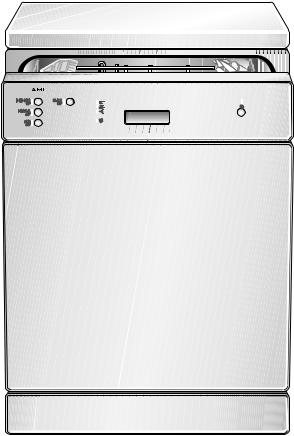
FAVORIT 40660 i
Dishwasher
User Instructions

Dear customer,
Please read these user instructions carefully.
Please observe the safety instructions on the first few pages of these user instructions! Please keep these user instructions for later reference. Pass them on to any subsequent owner of the appliance.
1 The warning triangle and/or specific words (Warning!, Caution!, Important!) are used to highlight instructions that are important for your safety or for the function of the appliance. It is imperative that these instructions are observed.
0This symbol or numbered instruction steps lead you step by step through the operation of the appliance.
3 |
Next to this symbol you receive additional information and practical |
|
tips on using the appliance. |
2 |
Tips and instructions for the economical and environmentally conscious |
|
use of the appliance are marked with a clover leaf. |
In the event of a malfunction, these operating instructions contain information on how to rectify faults yourself, see the "What to do, if..." section.
If these instructions are insufficient, please contact your AEG Service Force Centre.
In this respect please read the chapter "Service & Spare Parts".
Printed on paper manufactured with environmentally sound processes.
He who thinks ecologically acts accordingly ...
2

Contents |
|
CONTENTS |
|
Operating Instructions . . . . . . . . . . . . . . . . . . . . . . . . . . . . . . . . . . . . |
5 |
Safety Instructions . . . . . . . . . . . . . . . . . . . . . . . . . . . . . . . . . . . . . . . . . . . . |
5 |
Disposal . . . . . . . . . . . . . . . . . . . . . . . . . . . . . . . . . . . . . . . . . . . . . . . . . . . . . . |
7 |
Economical and Ecological Dishwashing . . . . . . . . . . . . . . . . . . . . . . . . . . |
7 |
Appliance Features and Control Panel . . . . . . . . . . . . . . . . . . . . . . . . . . . |
8 |
Control panel . . . . . . . . . . . . . . . . . . . . . . . . . . . . . . . . . . . . . . . . . . . . . . . |
9 |
Prior to using for the first time . . . . . . . . . . . . . . . . . . . . . . . . . . . . . . . . . |
10 |
Adjusting the water softener . . . . . . . . . . . . . . . . . . . . . . . . . . . . . . . . . . . . . |
10 |
Filling with Salt for the Water Softener . . . . . . . . . . . . . . . . . . . . . . . . . . . . |
12 |
Filling with Rinse Aid . . . . . . . . . . . . . . . . . . . . . . . . . . . . . . . . . . . . . . . . . . . . |
13 |
Adjusting Rinse Aid Dosing . . . . . . . . . . . . . . . . . . . . . . . . . . . . . . . . . . . . |
14 |
In Daily Use . . . . . . . . . . . . . . . . . . . . . . . . . . . . . . . . . . . . . . . . . . . . . . . . . . . |
15 |
Loading Cutlery and Dishes . . . . . . . . . . . . . . . . . . . . . . . . . . . . . . . . . . . . . . |
15 |
Loading Cutlery . . . . . . . . . . . . . . . . . . . . . . . . . . . . . . . . . . . . . . . . . . . . . |
16 |
Loading Pans, Frying Pans and Large Plates . . . . . . . . . . . . . . . . . . . . . . |
17 |
Loading Cups, Glasses and Coffee Services . . . . . . . . . . . . . . . . . . . . . . . |
18 |
Filling with Detergent . . . . . . . . . . . . . . . . . . . . . . . . . . . . . . . . . . . . . . . . . . . |
19 |
Bio Wash Programmes and Concentrated Detergents . . . . . . . . . . . . . . |
20 |
Selecting the Wash Programme (Programme Table) . . . . . . . . . . . . . . . . . . |
21 |
Start the wash programme . . . . . . . . . . . . . . . . . . . . . . . . . . . . . . . . . . . . . . . |
22 |
Interrupting or stopping the wash programme . . . . . . . . . . . . . . . . . . . |
22 |
Pause function . . . . . . . . . . . . . . . . . . . . . . . . . . . . . . . . . . . . . . . . . . . . . . |
23 |
Switching Off the Dishwasher . . . . . . . . . . . . . . . . . . . . . . . . . . . . . . . . . . . . |
23 |
Emptying the Dishwasher . . . . . . . . . . . . . . . . . . . . . . . . . . . . . . . . . . . . . |
23 |
Care and Cleaning . . . . . . . . . . . . . . . . . . . . . . . . . . . . . . . . . . . . . . . . . . . . . |
24 |
Cleaning the Filter . . . . . . . . . . . . . . . . . . . . . . . . . . . . . . . . . . . . . . . . . . . |
24 |
What to do, if ... . . . . . . . . . . . . . . . . . . . . . . . . . . . . . . . . . . . . . . . . . . . . . . |
26 |
...Fault warnings are displayed. . . . . . . . . . . . . . . . . . . . . . . . . . . . . . . . . . . . |
26 |
...there are problems operating the dishwasher. . . . . . . . . . . . . . . . . . . . . . |
27 |
...the wash results are unsatisfactory. . . . . . . . . . . . . . . . . . . . . . . . . . . . . . . |
27 |
Technical Data . . . . . . . . . . . . . . . . . . . . . . . . . . . . . . . . . . . . . . . . . . . . . . . . |
28 |
Notes for Test Institutes . . . . . . . . . . . . . . . . . . . . . . . . . . . . . . . . . . . . . . . . |
29 |
3

Contents
Installation and Connection Instructions . . . . . . . . . . . . . . . . |
30 |
Installing the Dishwasher . . . . . . . . . . . . . . . . . . . . . . . . . . . . . . . . . . . . . . . |
30 |
Dishwashers That Can Be Integrated . . . . . . . . . . . . . . . . . . . . . . . . . . . . |
31 |
Connecting the Dishwasher . . . . . . . . . . . . . . . . . . . . . . . . . . . . . . . . . . . . . |
32 |
Water Connection . . . . . . . . . . . . . . . . . . . . . . . . . . . . . . . . . . . . . . . . . . . . . . |
32 |
Permitted water pressure . . . . . . . . . . . . . . . . . . . . . . . . . . . . . . . . . . . . . |
32 |
Connect the inlet hose . . . . . . . . . . . . . . . . . . . . . . . . . . . . . . . . . . . . . . . |
32 |
Water drain . . . . . . . . . . . . . . . . . . . . . . . . . . . . . . . . . . . . . . . . . . . . . . . . . |
33 |
Leak Prevention System . . . . . . . . . . . . . . . . . . . . . . . . . . . . . . . . . . . . . . . |
34 |
Electrical Connection . . . . . . . . . . . . . . . . . . . . . . . . . . . . . . . . . . . . . . . . . . . |
35 |
Connections . . . . . . . . . . . . . . . . . . . . . . . . . . . . . . . . . . . . . . . . . . . . . . . . . . . |
36 |
Guarantee Conditions . . . . . . . . . . . . . . . . . . . . . . . . . . . . . . . . . . . . . |
37 |
Service & Spare parts . . . . . . . . . . . . . . . . . . . . . . . . . . . . . . . . . . . . . |
39 |
4

Operating Instructions
OPERATING INSTRUCTIONS
1 Safety Instructions
The safety aspects of AEG electrical appliances comply with accepted technical standards and the German Appliance Safety Law. Nevertheless, as a manufacturer we consider it our obligation to make you aware of the following safety information:
Installation, Connection and Placing into Operation
•The dishwasher may only be transported upright.
•Check the dishwasher for transport damage. Do not in any circumstances connect an appliance that is damaged. In the case of damage, please contact your retailer.
•Before installing the appliance, ensure that the nominal voltage and type of supply on the rating plate match that of the supply where the appliance is to be installed. The fuse rating is also to be found on the rating plate.
•For information on how to correctly install and connect up your dishwasher, please read the “Installation“ section. Adaptors / connectors and extension cables must not be used.
Child Safety
•This appliance is designed to be operated by adults. Children should not be allowed to tamper with the controls or play with the product.
•Keep all packaging away from children.
•Keep all detergents in a safe place out of children’s reach.
•The water in your dishwasher is not suitable for drinking. If there are still remnants of detergent in the appliance, there is a risk of burns!
•When disposing of an old appliance, cut off the power supply cable and remove any door catches, to prevent young children being trapped inside.
General Safety
•Repairs to the dishwasher are only to be carried out by qualified service engineers. Improper repairs can give rise to significant hazards for the user. If your appliance needs repairing, please contact your local AEG Service Force Centre.
5

Operating Instructions
•Never place the dishwasher in operation if the mains cable, water inlet or drain hose is damaged; or the control panel, work top or plinth area is damaged such that the inside of the appliance is freely accessible.
•If the mains lead is damaged, or is to be replaced for a longer lead, the cable (obtainable from AEG Service Force) must be replaced by a service engineer authorised by AEG.
•Never unplug the appliance by pulling on the cable, always pull the plug.
•Additions or modifications to the dishwasher are not permitted for safety reasons.
•Ensure that the door of the dishwasher is always closed when it is not being loaded or unloaded. In this way you will avoid anybody tripping over the open door and hurting themselves.
•Long bladed knives stored in an upright position are a potential hazard.
•Long and/or sharp items of cutlery such as carving knives must be positioned horizontally in the upper basket.
•When finished loading or unloading, close the door as an open door can be a hazard.
Correct Use
•Only wash household dishes using the dishwasher. If the appliance is used for other purposes, or is used incorrectly, the manufacturer cannot accept any liability for any damage caused.
•Only use detergents specifically designed for use in domestic dishwashers.
•Do not put any solvents in the dishwasher. There is a risk of an explosion!
•The anti-flood system provides dependable protection against damage due to leaks. For this system to function correctly, the following preconditions must be met:
–The appliance must remain connected to the mains even when it is switched off.
–The dishwasher must be correctly installed.
–Always shut off the water supply at the tap when the dishwasher is not to be used for longer periods, e.g. when you are away on holiday.
•Do not sit or stand on the open door, the appliance may tip over.
6

Operating Instructions
•In the event of a fault, first close the tap, then switch off the appliance and unplug it from the mains. If the appliance is permanently wired to the mains: remove the fuse.
2 Disposal
Disposing of the Packaging Material
Dispose of the dishwasher packaging material correctly. All the packaging materials used are harmless to the environment and can be recycled.
• Plastic parts are marked with standard international abbreviations:
– >PE< |
for polyethylene, e.g. sheet wrapping material |
– >PS< |
for polystyrene, e.g. padding material (always CFC-free) |
– >POM< |
for polyoxymethylene, e.g. plastic clips |
•Cardboard packaging is manufactured from recycled paper and should be deposited in the waste paper collection for recycling.
Disposal of Old Appliances
When disposing of old appliances, remove the plug and ensure that any locks or catches are removed to prevent young children becoming trapped inside.
Use an authorised disposal site.
2Economical and Ecological Dishwashing
•Ensure that the water softener is correctly adjusted.
•Do not pre-rinse dishes under running water.
•Select the wash programme to suit the nature and degree of the soiling on the dishes.
•Do not use more detergent, special salt or rinse aid than is recommended in these operating instructions and by the detergent manufacturer.
7
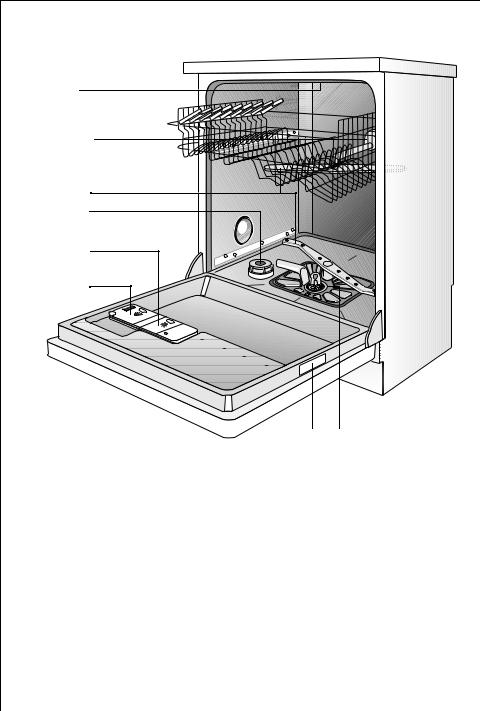
Operating Instructions
Appliance Features and Control Panel |
|
Top Spray |
|
Nozzle |
|
Rubber Seal for |
|
Connecting the |
|
Water Feed to |
|
the Upper Spray |
|
Arm |
|
Spray Arms |
|
Container for |
|
Salt |
|
Container |
|
for Rinse Aid |
|
Detergent |
|
Dispenser |
|
Rating |
Filters |
Plate |
|
8 |
|
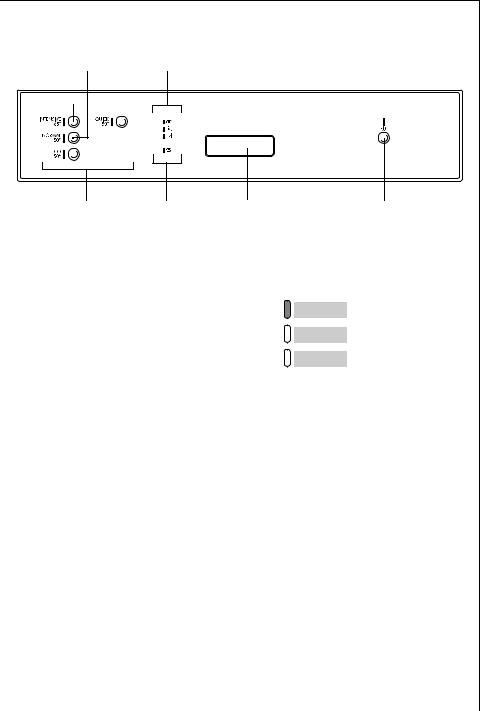
Operating Instructions
Control panel
Water sofFunction |
|
tener button button |
Multi-display |
Wash programme buttons Control indicator Door handle |
ON / OFF button |
Water softener and function button: In addition to the wash programme marked, it is also possible to adjust the dishwasher's water softener using a combination of these buttons.
The 3 lights of the multi-display can display:
– the current stage of the selected wash programme.
–which fault has occurred in the dishwasher.
The control indicator indicates the following:
:Upper light
:Middle light
:Lower light
|
|
J |
Refill with salt |
|
|
|
|
3 |
The control indicator does not illuminate while a wash programme is |
||
|
running. |
|
|
9

Operating Instructions
Prior to using for the first time
Prior to using for the first time, remove all the clips with which the dish racks are secured for transport.
Then perform the following steps: 0 1. Adjust the water softener
2.Fill with Salt for the Water Softener
3.Fill with Rinse Aid
Adjusting the water softener
|
To avoid scale deposits on the dishes and in the dishwasher, the dishes |
|
must be washed with soft water i.e. low lime content. The dishwasher |
|
therefore has a built-in water softener, in which tap water from a |
|
hardness of 4 °d (German degree) is softened with the aid of special |
|
salt. |
3 |
Your water supplier will be able to inform you about the hardness |
|
range of the water in your area. |
The water softener can be set to any of 5 settings:
|
Water hardness |
|
Adjust |
Number of |
in °d 1) |
in PPM 2) |
Range |
to hardness setting |
flashes |
|
|
|
|
|
41 - 50 |
730 - 900 |
IV |
5 |
5 |
30 - 40 |
530 - 720 |
IV |
4 |
4 |
19 - 29 |
330 - 520 |
III/IV |
3 * |
3 |
4 - 18 |
70 - 320 |
I/II/III |
2 |
2 |
|
|
|
1 |
|
under 4 |
under 70 |
I |
no salt |
1 |
|
|
|
necessary |
|
|
|
|
|
|
1)(°d) German degree, measure of the hardness of water 2)PPM, parts per million, international units of water hardness *factory setting
Adjust the water softener in accordance with the table to suit the water hardness in your area:
10

Operating Instructions
1 The hardness range cannot be set if a programme is running. If you have inadvertently started a programme (an LED indicator is constantly illuminated) the programme must be cancelled by pressing the appropriate button.
1.The appliance must be switched off.
2.Press the water softener button and the function button simultaneously and hold them down.
3.In addition press the ON/OFF button.
4.At first the LED indicator for the water softener button will light up continuously for 5 seconds and then begin to flash.
–The number of flashes corresponds to the hardness setting.
–The sequence of flashes is repeated several times after a 5 second pause.
5.Each time you press the water softener button the hardness setting will go up by 1.
(Exception: Hardness setting 1 follows after hardness setting 5.)
6.If the hardness setting is changed, the LED indicator for the water softener button will confirm the change by staying alight continuously for 5 seconds and then flashing again.
7.The number of flashes corresponds to the new hardness setting.
8.The sequence of flashes is repeated several times after a 5 second pause.
9.Once the hardness setting is correct, press the ON/OFF switch. The hardness setting is then saved.
11
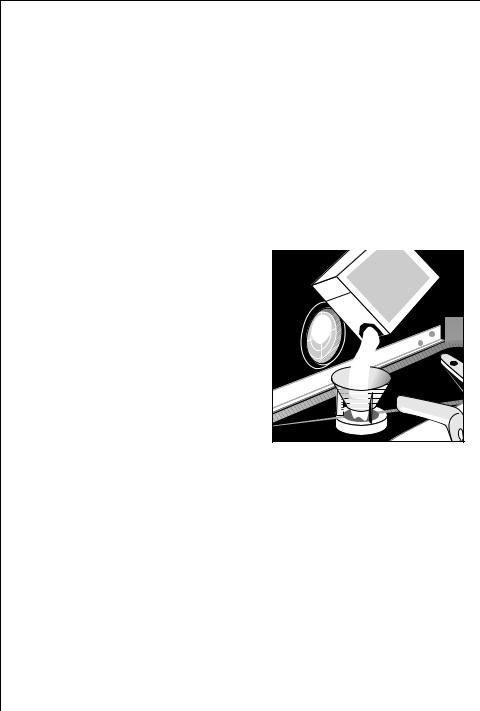
Operating Instructions
Filling with Salt for the Water Softener
1 Use only salt designed for dishwashers. Never fill the salt container with any another type of salt (e.g. culinary salt) or dishwasher detergent as this would irreparably damage the water softener.
Prior to filling with salt, please check each time that you really do have a packet of dishwasher salt in your hand.
Fill with dishwasher salt:
–Prior to using the dishwasher for the first time
–When the SALT indicator Jon the control panel is illuminated.
3 |
If the water hardness in your area is less than 4 °d, you do not need to |
||
|
use dishwasher salt. The SALT indicator Jon the control panel will |
||
|
remain illuminated. |
|
|
0 1. |
Open the door, remove the lower |
|
|
|
|
||
|
|
||
|
rack. |
SALE |
|
|
|
||
|
|
||
|
|
||
|
|
|
|
|
|
|
|
2. |
Undo the lid on the salt container by |
SALT |
|
|
|||
|
|
SALZ |
|
|
|
|
|
|
turning it anticlockwise. |
SEL |
|
|
|
|
|
3.When using for the first time: fill the salt container with water.
4.Place the funnel supplied on the con- 
tainer opening.
Fill the container with salt through 


the funnel; the capacity of the con- 
 tainer is approx. 1.0-1.5 kg depend-
tainer is approx. 1.0-1.5 kg depend-  ing on the grain size. Do not overfill
ing on the grain size. Do not overfill
the salt container with salt.
3 |
The water expelled by filling the salt container with salt runs out of the |
|
salt container onto the base of the washing compartment. This is not a |
cause for concern, the water will be pumped out at the start of the next wash programme.
5.Clean any salt remnants on the container opening.
6.Turn the lid clockwise to the stop, otherwise dishwasher salt will leak into the wash water, this could lead to poor wash results. To avoid this run a rinse programme after filling the salt container with special salt. This will wash away salt water and any salt crystals that have been spilt.
3 |
Depending on the size of the salt grains, it can take several hours for |
|
the salt to dissolve in the water and the special salt indicator Jto |
extinguish. The setting of the water softener and the consumption of salt are dependent on the hardness of the local water.
12
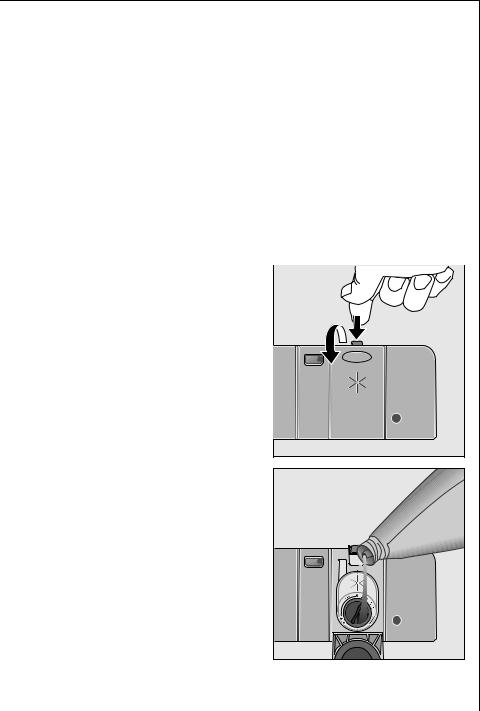
Operating Instructions
Filling with Rinse Aid
|
Rinse aid is automatically added during the last rinse, ensuring thor- |
|
ough rinsing, spot and streak free drying. |
1 |
Only use rinse aid specifically designed for domestic dishwashers. Never |
|
fill the rinse aid container with any other substance as this would dam- |
age the appliance.
Fill with rinse aid:
–Prior to using the dishwasher for the first time
–When the window indicator has a dark centre surrounded by a light ring. If there is sufficient rinse aid in the container, the indicator window is completely dark.
The rinse aid compartment is on the inside of the dishwasher door. 0 1. Open the door. 
2. Press the rinse aid compartment release button with your finger.
3. Fully open the rinse aid compartment lid.
4.Fill with rinse aid exactly up to the level marked “max”; this corresponds to a quantity of approx. 140 ml.
5.Close the lid and press until it locks
into place.
6. Wipe up any spilt rinse aid with a cloth. Otherwise too much foam will be formed during the wash.
13
